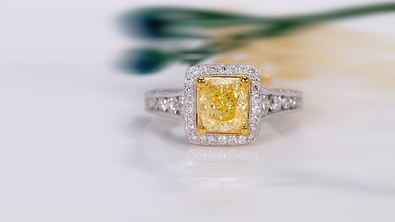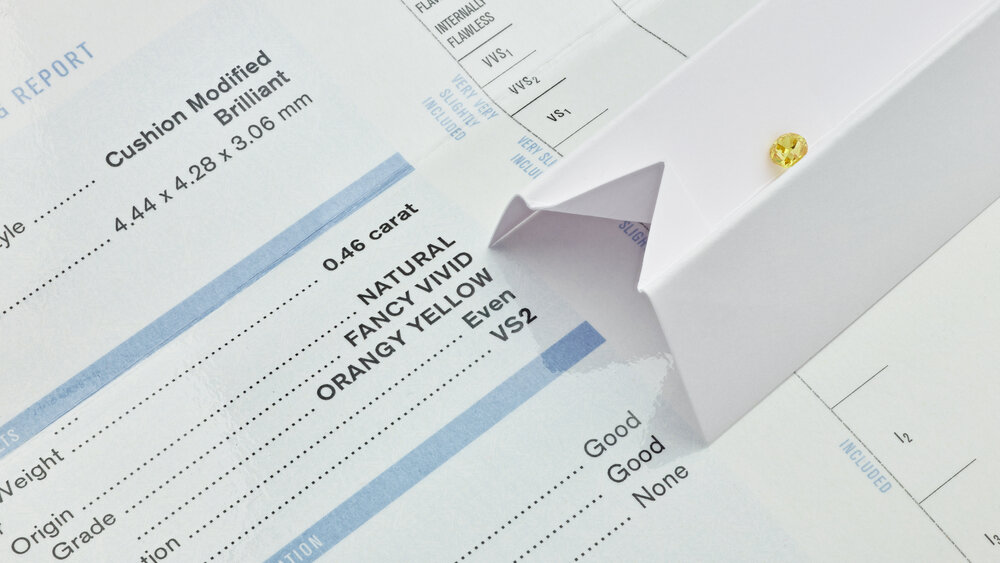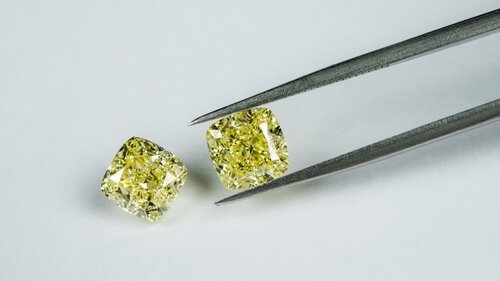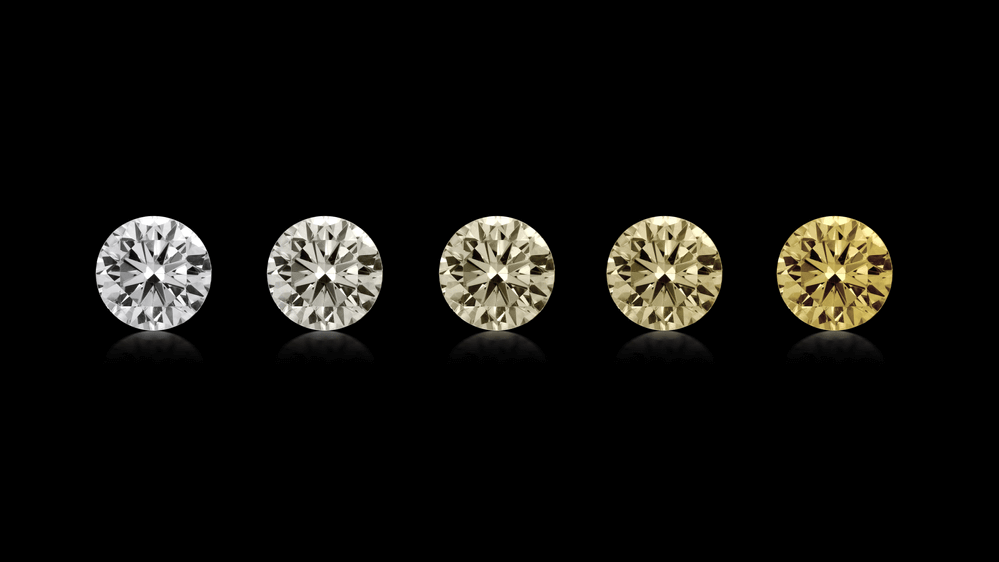Blue Yellow Pink: The Magic of Fancy Color Diamonds

By Gary A.

Edited by Olivia H.
Published Aug 8, 2024
Edited on Mar 31, 2025
From vivid blues to radiant pinks, fancy color diamonds add a unique touch of brilliance, making them a stunning alternative to traditional white diamonds.

Navigate This Guide:
- 7 Quick Tips for Buying a Fancy Color Diamond Engagement Ring
- Introduction to Fancy Color Diamond
- The Science Behind the Colors
- Grading the Rainbow: Understanding Fancy Diamond Ratings
- Deciphering Hue, Tone, and Saturation
- Natural vs. Lab-Created: A Comparative Analysis
- Our Expert Take
- 10 Frequently Asked Questions About Fancy Color Diamonds
Before we dive deeper into the specifics, here are some practical tips to help guide your decision-making process:
7 Quick Tips for Buying a Fancy Color Diamond Engagement Ring
When purchasing a fancy color diamond engagement ring, it’s crucial to consider various factors to ensure you’re making a wise investment and choosing a ring that resonates with personal taste and style. Here are some key tips to guide you through this process:
- Tip 1: Understanding the Impact of Color on Value
- Color Intensity Matters: The value of a fancy color diamond is largely dependent on its color intensity. The most sought-after grades are “Fancy Intense” and “Fancy Vivid.” Ensure the color is evenly distributed and appears vibrant and rich.
- Hue Purity is Crucial: Opt for diamonds with pure hues without overtones (e.g., a pure pink diamond rather than one with brownish or orangish secondary tones). The purer the hue, the more valuable the diamond.
- Tip 2: Scrutinizing the Cut for Optimal Brilliance
- Cut for Color Enhancement: Unlike traditional white diamonds where cut is aimed at maximizing brilliance, the cut in fancy color diamonds is intended to enhance the stone’s color. Look for a cut that deepens and intensifies the diamond’s hue.
- Shape and Appearance: Certain shapes can enhance the color perception. For instance, radiant and cushion cuts are known to intensify color, making them popular choices for fancy color diamonds.
- Tip 3: Clarity and Carat – Balancing Size with Quality
- Clarity Considerations: While clarity is important, it can take a backseat in fancy color diamonds. Inclusions that aren’t visible to the naked eye can be acceptable, as color is the primary focus. However, avoid diamonds with inclusions that undermine structural integrity.
- Carat Weight vs. Color: Larger fancy color diamonds are rarer, but remember, color intensity should not be compromised for size. A smaller diamond with a rich, intense color can be more valuable than a larger one with a weaker color.
- Tip 4: Evaluating the Origin: Natural vs. Treated
Authenticity of Color: Ensure that the color is natural and not a result of artificial treatments. Request a gemological certificate that verifies the diamond’s natural color. Treated diamonds are less valuable and may not hold their color over time.
- Tip 5: Considering the Setting for Maximum Impact
Setting Matters: The right setting can significantly enhance the diamond’s color. For example, yellow gold can amplify the warmth of yellow diamonds, while white gold or platinum can accentuate cooler tones like blues and greens.
- Tip 6: Be Informed About Pricing and Rarity
Understanding Price Variables: Familiarize yourself with the factors that affect pricing. Rare colors like blue, pink, and red tend to be more expensive. The price can also vary significantly based on the 4Cs – Cut, Color, Clarity, and Carat.
- Tip 7: Reflect on Personal Preferences and Longevity
Personal Style and Trends: Choose a color and style that suits personal taste and lifestyle. While some colors are trendy, others are timeless classics. Consider how the ring will fit with the wearer’s everyday life and personal style.
Now that you’ve got these practical tips, use Jeweler AI below to find the perfect engagement ring that suits your style and budget:
Introduction to Fancy Color Diamond
Diamonds come in a huge variety of shapes and sizes – and, while you may not realize it yet, colors, too. From deep reds to rosy pinks, canary yellows to blue deeper than the most intense sapphire, these are known as fancy color diamonds.
Before we get started, it’s important to keep in mind that fancy color diamonds do not fall under the same topic as diamond color, one of the Four Cs. White diamonds – in other words, the diamonds you’re most used to seeing – naturally form with trace amounts of elements that can give them an unwanted yellow cast. A white diamond with a visible amount of yellow in it is given a low color grade, and, accordingly, a lower price.
A fancy color yellow diamond, on the other hand, is a very popular option for buyers. The Tiffany Yellow diamond is a perfect example of their unique charm.
So, here’s everything you need to know about fancy color diamonds.
The Allure of Rare Hues in Fancy Color Diamonds
While white diamonds are the quintessential choice for an engagement ring, fancy color diamonds have a very unique appeal of their own. For one thing, fancy color diamonds are very rare; as we’ll explore below, they’re a product of a series of unlikely natural events that took place deep beneath the earth’s surface billions of years ago. While all diamonds are somewhat rare, fancy color diamonds are true collectors’ items.
There are so many different shades and hues of fancy color diamonds, and no two are exactly alike.
But, beyond the high social status attached to these items, they also look beautiful. While sapphires are popular in their own right, a deep blue fancy color diamond brings the unrivaled fire and brilliance that can only ever happen across a diamond’s surface – although it’s worth noting that blue diamonds as vivid as sapphires are quite rare, and highly coveted by collectors. No other gemstone produces a comparable sparkle – so, whether you’ve got a soft spot for rubies, emeralds, sapphires or Topaz, a diamond can offer the same…just better.
But it’s not just about improving on sparkle. As the hardest natural substance in the world, diamonds are the wisest choice for any piece of jewelry that is intended to be worn and loved for many, many years to come. Other gemstones, while beautiful, can all too easily become scratched, chipped, or broken. Fancy color diamonds possess all the beneficial traits of white diamonds and come in every color a buyer or collector could want.

The Science Behind the Colors
Diamonds are formed from carbon, and the unique process that drove their formation would, under ‘ideal’ conditions, produce a clear stone. Again, this is the sort of diamond most of us are used to seeing.
But, as we mentioned, the presence of trace elements and pollutants deep underground means that no diamond can be considered totally pure. Even diamonds with the highest possible color grade – D – will have some color, although it won’t be detectable by an expert, even under strict lab conditions.
Elemental Influence on Diamond Hues
Fancy colors are produced in much the same way – thanks to the presence of ‘pollutants’ that became interwoven with the diamond’s crystalline structure and irrevocably altered the diamond’s appearance.
For instance, the presence of blue in diamonds is the result of trace amounts of boron, while yellow and orange are caused by the chemical nitrogen. Different amounts of these chemicals will cause diamonds of all different shades and levels of vividity.
The key exception to the rule is pink – and, potentially, red. Pink and red diamonds, for all their romantic connotations, are generally considered to be the rarest
Grading the Rainbow: Understanding Fancy Diamond Ratings
Fancy color diamonds come in all different levels of vividity, from the palest trace to heavy saturation. Like Color in clear diamonds, Fancy Color needs to be graded on a scale in order for buyers to make sound decisions. This is particularly important if a piece of jewelry is to feature more than one diamond. If they’re not the same grade, they won’t always look right alongside each other.
But, even if you’re looking for a single stone, understanding where your ‘ideal’ range on the grading scale is, is key.
GIA’s Comprehensive Grading System
As always, the GIA is the best lab for grading diamonds, whether you’re looking for a D color clear diamond or one in ruby red. Their commitment to offering transparency and clear, consistent results to experts and shoppers alike is what makes them the industry-leader, and it’s exactly why we only offer our customers GIA certified diamonds.
The fancy color diamond scale doesn’t run from D to Z as it does for clear diamond color. Instead, fancy color diamonds are given one of the following grades:
| Fancy Light | Fancy | Fancy Intense | Fancy Vivid |
From Faint to Vivid: Knowing the Difference
Unlike the clear diamond color grades, even non-experts will be able to spot a clear difference between a diamond of one color grade, and a diamond of the next grade along the scale. With only four grades in total, there’s quite a big sway between one and another.
Fancy light diamonds will feature only a fleeting trace of color. It will be enough to see with the naked eye, but only a subtle addition to the stone’s fire and brilliance.
Fancy vivid diamonds feature the very most amount of color. A fancy vivid blue diamond will look like a sapphire (save for that sparkle), in the same way that a fancy vivid red diamond will look like a ruby. They will still stand out as diamond, but feature the colors we tend to associate with other gemstones.

Deciphering Hue, Tone, and Saturation
It helps to get these separate terms straight in your head. Remember that hue refers to color – say, yellow, brown, red, pink. It’s the broadest term of the three.
Tone refers to the brightness or dullness of the color. For instance, more often than not, blue diamonds feature a noticeable amount of grey. This dulls the tone – although a lot of people like the effect.
Saturation is the strength or weakness of a color. Consider the difference between a glass of juice straight out of the refrigerator, and a glass of juice that has been diluted by a handful of melting ice cubes. Some diamonds feature more ‘pollutants’ than others, making them appear more saturated than the rest.
The Enigma of Pink Diamonds
Pink diamonds – and, by extension, red diamonds too – are something of a mystery in the world of gemstones. While we know what pollutants cause a yellow, orange, blue or green diamond, pink diamonds are thought to be caused by structural irregularities within the diamond. These irregularities may have been caused by a very specific event – a seismic shock – forced diamonds to rise to the surface incredibly fast.
There are a lot of other theories out there but suffice to say that pink and red diamonds are among the rarest. They are beloved for their romantic appearance – and the mystery surrounding their creation – and very few will be able to lay claim to one.
Pink Diamonds Color Grading System
Categories of Pink Diamonds:
- Purplish Pink (PP): These diamonds exhibit a slight purplish hue combined with pink. They are less pure in pink coloration compared to the other categories.
- Pink (P): These diamonds represent the standard pink hue without significant modifiers. They are highly sought after for their vibrant pink tone.
- Pink Rosé (PR): These diamonds have a softer, rosier pink hue, appearing slightly lighter and more delicate compared to standard pink diamonds.
Grading Scale for Intensity:
Each category is graded based on the intensity of its color, from lightest (9) to most vivid (1). For example:
- 9PP, 9P, 9PR: Lightest shades in their respective categories, appearing closer to white with a hint of pink.
- 1PP, 1P, 1PR: The most vivid and saturated hues, showing the strongest pink coloration.
Red and Purplish Red:
These are the most intense and rarest variations, beyond the standard pink grading. They are graded distinctly as they represent unique hues, such as pure red or a mix of red and purple.

Yellow and Other Vivid Shades
Yellow is far more common, and the Tiffany Diamond – a beautiful, canary yellow stone of 128.54 carats – has been worn by celebrity royalty including Audrey Hepburn and Lady Gaga over the years. Heidi Klum, Victoria Beckham, and Carrie Underwood all received engagement rings featuring yellow diamonds.
Similar impurities cause brown and orange diamonds, both of which are also relatively commonplace.
Green diamonds are a trickier subject. While beautiful, these diamonds are relatively rare in nature. Unfortunately, artificial processes can be conducted using radiation to create a green cast in a clear diamond. The GIA can detect diamonds that have been made green after mining, however, so, provided you shop from a trusted source (and focus only on diamonds with a GIA report), you needn’t worry about accidentally buying a fake green diamond.
Exploring Lesser-Known Colors
Brown is one of the less sought-after colors, since it doesn’t have quite the same eye-catching appeal as a bright red or blue – or, at least, that’s what first-time shoppers assume. In reality, brown diamonds are very beautiful; with that fire and brilliance dancing across its facets, any fears of a ‘dull’ or ‘muddy’ looking diamond are quick to disappear. Brown diamonds have a warm, regal look, and they look particularly good in a yellow gold setting to match those undertones.
Two other underestimated diamond colors are grey and black. Again, first-time shoppers assume these diamonds will be less conspicuous and more forgettable, but that fire and brilliance once again proves that any hue can be beautiful and arresting.
Natural vs. Lab-Created: A Comparative Analysis

The debate between natural and lab-grown fancy color diamonds will ultimately end the same way, for you, as the debate between natural and lab-grown clear diamonds.
Since fancy color diamonds are, for the most part, caused by trace amounts of pollutants, it is possible for lab grown diamonds to be created in a range of different hues and levels of saturation. However, the same constraints on natural diamonds exist for lab grown diamonds; pink and red remain elusive colors that cannot be replicated until we understand what causes pink or red in natural diamonds.
For any shopper, deciding where you stand on the natural versus lab debate is key. Lab grown diamonds are cheaper, and they are free from the risks of unethical mining practices. However, as we explore in our guides to ethical diamonds, the overwhelming majority of diamonds in the world—and all diamonds available on our site—are mined according to strict codes of conduct.
Natural diamonds are seductive because of their history. These stones are ancient, one-of-a-kind, and the rare result of an incredibly savage natural process that took place many miles underground. Lab grown diamonds don’t have that same meaning attached to them.
As a shopper, you need to decide whether you want to invest a little bit more into a diamond’s history and romantic symbolism, or invest in a slightly larger diamond that has been created artificially. There’s no right or wrong answer.
Our Expert Take
There’s no arguing the appeal of fancy color diamonds. While they may not be the quintessential choice for a diamond engagement ring, the unique properties of diamonds mean that they will never be confused with an inferior gemstone. Provided you place the same emphasis on cut quality and focus on finding an eye-clean diamond, your choice will be breathtaking, whether it’s clear, yellow, brown, or blue.
10 Frequently Asked Questions About Fancy Color Diamonds
- Q: What makes a diamond a ‘fancy color’ diamond?
- A: A fancy color diamond displays a color beyond the typical white or yellow shades, ranging from blue and green to pink, orange, or even black. These colors are due to specific geological conditions during the diamond’s formation.
- Q: Are fancy color diamonds natural or treated?
- A: Both exist. Natural fancy color diamonds get their hues from unique conditions during formation, while treated diamonds are enhanced artificially. Always verify the origin of the color through certification.
- Q: Which fancy color diamond is the rarest?
- A: Red diamonds are considered the rarest, followed closely by blue and pink. Their scarcity significantly influences their value.
- Q: How is the value of a fancy color diamond determined?
- A: The value is primarily based on the color’s intensity and purity. Other factors like cut, clarity, and carat also play a role, but color is the most critical aspect.
- Q: Can fancy color diamonds be part of an investment portfolio?
- A: Yes, due to their rarity, certain fancy color diamonds, especially those with intense and vivid hues, can be valuable assets and have shown to appreciate over time.
- Q: How should I care for my fancy color diamond jewelry?
- A: Care for fancy color diamonds as you would any fine jewelry. Regular cleaning, avoiding harsh chemicals, and professional inspections are recommended to maintain their brilliance and color.
- Q: Are there specific cuts that enhance the color of fancy diamonds?
- A: Yes, certain cuts like radiant and cushion are known to intensify the diamond’s color. The cut should maximize the color visibility rather than just focus on brilliance.
- Q: Is it necessary to get a gemological certificate for a fancy color diamond?
- A: Absolutely. A gemological certificate provides crucial information about the diamond’s natural color, treatments (if any), and overall quality, ensuring authenticity and value.
- Q: Can the color of a fancy diamond fade over time?
- A: The color of natural fancy diamonds does not fade. However, treated or enhanced diamonds may experience color changes over time, emphasizing the importance of knowing the diamond’s origin.
- Q: Are fancy color diamonds more expensive than white diamonds?
- A: It depends on the color. Some fancy colors like yellow and brown may be comparable or less in price, while rare colors like blue, pink, and red are typically much more expensive.
Discover the spectrum of Fancy Color Diamonds with Jeweler AI – your gateway to the rarest, most captivating diamonds tailored to your unique taste.
FOLLOW-UP GUIDE SERIES












